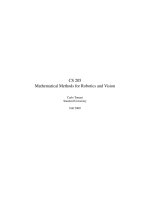CS 205 Mathematical Methods for Robotics and Vision - Chapter 2 pps
Bạn đang xem bản rút gọn của tài liệu. Xem và tải ngay bản đầy đủ của tài liệu tại đây (137.91 KB, 15 trang )
Chapter 2
Algebraic Linear Systems
An algebraic linear system is a set of equations in unknown scalars, which appear linearly. Without loss of
generality, an algebraic linear system can be written as follows:
x b (2.1)
where is an matrix, x is an -dimensional vector that collects all of the unknowns, and b is a known vector
of dimension . In this chapter, we only consider the cases in which the entries of , b, and x are real numbers.
Two reasons are usually offered for the importance of linear systems. The first is apparently deep, and refers to the
principle of superposition of effects. For instance, in dynamics, superposition of forces states that if force f produces
acceleration a (bothpossiblyvectors) andforce f produces acceleration a , thenthe combinedforce f f produces
acceleration a a . This is Newton’s second law of dynamics, although in a formulation less common than the
equivalent f a. Because Newton’s laws are at the basis of the entire edifice of Mechanics, linearity appears to be a
fundamental principle of Nature. However, like all physical laws, Newton’s second law is an abstraction, and ignores
viscosity, friction, turbulence, and other nonlinear effects. Linearity, then, is perhaps more in the physicist’s mind than
in reality: if nonlinear effects can be ignored, physical phenomena are linear!
A more pragmatic explanation is that linear systems are the only ones we know how to solve in general. This
argument, which is apparently more shallow than the previous one, is actually rather important. Here is why. Given
two algebraic equations in two variables,
we can eliminate, say, and obtain the equivalent system
Thus, the original system is as hard to solve as it is to find the roots of the polynomial in a single variable.
Unfortunately, if and have degrees and , the polynomial has generically degree .
Thus, the degree of a systemof equations is, roughlyspeaking, theproduct ofthe degrees. For instance, a system of
quadratic equations corresponds to a polynomial of degree . The only case in which the exponential is harmless
is when its base is , that is, when the system is linear.
In this chapter, we first review a few basic facts about vectors in sections 2.1 through 2.4. More specifically, we
develop enough language to talk about linear systems and their solutions in geometric terms. In contrast with the
promise made in the introduction, these sections contain quite a few proofs. This is because a large part of the course
material is based on these notions, so we want to make sure that the foundations are sound. In addition, some of the
proofs lead to useful algorithms, and some others prove rather surprising facts. Then, in section 2.5, we characterize
the solutions of linear algebraic systems.
7
8 CHAPTER 2. ALGEBRAIC LINEAR SYSTEMS
2.1 Linear (In)dependence
Given vectors a a and real numbers , the vector
b a (2.2)
is said to be a linear combination of a
a with coefficients .
The vectors a a are linearly dependent if they admit the null vector as a nonzero linear combination. In
other words, they are linearly dependent if there is a set of coefficients , not all of which are zero, such that
a 0 (2.3)
For later reference, it is useful to rewrite the last two equalities in a different form. Equation (2.2) is the same as
x b (2.4)
and equation (2.3) is the same as
x 0 (2.5)
where
a a x
.
.
.
b
.
.
.
If you are not convinced ofthese equivalences, take the time towrite out the components of each expression for a small
example. This is important. Make sure that you are comfortable with this.
Thus, the columns of a matrix are dependent if there is a nonzero solution to the homogeneous system (2.5).
Vectors that are not dependent are independent.
Theorem 2.1.1 The vectors a a are linearly dependent iff at least one of them is a linear combination of the
others.
Proof. In one direction, dependency means that there is a nonzero vector x such that
a 0
Let be nonzero for some . We have
a a a 0
so that
a a (2.6)
as desired. The converse is proven similarly: if
a a
“iff” means “if and onlyif.”
2.2. BASIS 9
for some
, then
a 0
by letting (so that x is nonzero).
We can make the first part of the proof above even more specific, and state the following
Lemma 2.1.2 If nonzero vectors a a are linearly dependent then at least one of them is a linearcombination
of the ones that precede it.
Proof. Just let be the last of the nonzero . Then for in (2.6), which then becomes
a a
as desired.
2.2 Basis
A set a a is said to be a basis for a set of vectors if the a are linearly independent and every vector in can
be written as a linear combination of them. is said to be a vector space if it contains all the linear combinations of
its basis vectors. In particular, this implies that every linear space contains the zero vector. The basis vectors are said
to span the vector space.
Theorem 2.2.1 Given a vector b in the vector space and a basis a a for , the coefficients such
that
b a
are uniquely determined.
Proof. Let also
b a
Then,
0 b b a a a
but because the a are linearly independent, this is possible only when for every .
The previous theorem is a very important result. An equivalent formulation is the following:
If the columns a a of are linearly independent and the system x b admits a solution, then
the solution is unique.
This symbol marks the end of a proof.
10 CHAPTER 2. ALGEBRAIC LINEAR SYSTEMS
Pause for a minute to verify that this formulation is equivalent.
Theorem 2.2.2 Two different bases for the same vector space have the same number of vectors.
Proof. Let a
a and a a be two different bases for . Then each a is in (why?), and can therefore
be written as a linear combination of a a . Consequently, the vectors of the set
a a a
must be linearly dependent. We call a set of vectors that contains a basis for a generating set for . Thus, is a
generating set for .
The rest of the proof now proceeds as follows: we keep removing a vectors from and replacing them with a
vectors in such a way as to keep a generating set for . Then we show that we cannot run out of a vectors before we
run out of a vectors, which proves that . We then switch the roles of a and a vectors to conclude that .
This proves that .
From lemma 2.1.2, one of the vectors in is a linear combination of those preceding it. This vector cannot be a ,
since it has no other vectors preceding it. So it mustbe one of the a vectors. Removing the latterkeeps a generating
set, since the removed vector depends on the others. Now we can add a to , writing it right after a :
a a
is still a generating set for .
Let us continue this procedure until we run out of either a vectors to remove or a vectors to add. The a vectors
cannot run out first. Suppose in fact per absurdum that is now made only of a vectors, and that there are still
left-over a vectors that have not been put into . Since the a s form a basis, they are mutually linearly independent.
Since is a vector space, all the a s are in . But then cannot be a generating set, since the vectors in it cannot
generate the left-over a s, which are independent of those in . This is absurd, because at every step we have made
sure that remains a generating set. Consequently, we must run out of a s first (or simultaneously with the last a).
That is, .
Now we can repeat the whole procedure with the roles of a vectors and a vectors exchanged. This shows that
, and the two results together imply that .
A consequence of this theorem is that any basis for R has vectors. In fact, the basis of elementary vectors
e th column of the identity matrix
is clearly a basis for R , since any vector
b
.
.
.
can be written as
b e
and the e are clearly independent. Since this elementary basis has vectors, theorem 2.2.2 implies that any other
basis for R has vectors.
Another consequence of theorem 2.2.2 is that vectors of dimension are bound to be dependent, since any
basis for R can only have vectors.
Since all bases for a space have the same number of vectors, it makes sense to define the dimension of a space as
the number of vectors in any of its bases.
2.3. INNER PRODUCT AND ORTHOGONALITY 11
2.3 Inner Product and Orthogonality
In this section we establish the geometric meaning of the algebraic notions of norm, inner product, projection, and
orthogonality. The fundamental geometric fact that is assumed to be known is the law of cosines: given a triangle with
sides (see figure 2.1), we have
where is the angle between the sides of length and . A special case of this law is Pythagoras’ theorem, obtained
when .
θ
c
b
a
Figure 2.1: The law of cosines states that .
In the previous section we saw that any vector in R can be written as the linear combination
b e (2.7)
of the elementary vectors that point along the coordinate axes. The length of these elementary vectors is clearly one,
because each of them goes from the origin to the unit point of one of the axes. Also, any two of these vectors form a
90-degree angle, because the coordinate axes are orthogonal by construction. How long is b? From equation (2.7) we
obtain
b e e
and the two vectors e and e are orthogonal. By Pythagoras’ theorem, the square of the length b of b is
b e
Pythagoras’ theorem can now be applied again to the last sum by singling out its first term e , and so forth. In
conclusion,
b
This result extends Pythagoras’ theorem to dimensions.
If we define the inner product of two -dimensional vectors as follows:
b c
then
b b b (2.8)
Thus, the squared length of a vector is the inner product of the vector with itself. Here and elsewhere, vectors are
column vectors by default, and the symbol makes them into row vectors.
12 CHAPTER 2. ALGEBRAIC LINEAR SYSTEMS
Theorem 2.3.1
b
c b c
where is the angle between b and c.
Proof. The law of cosines applied to the triangle with sides b , c , and b c yields
b c b c b c
and from equation (2.8) we obtain
b
b c c b c b b c c b c
Canceling equal terms and dividing by -2 yields the desired result.
Corollary 2.3.2 Two nonzero vectors b and c in R are mutually orthogonal iff b c .
Proof. When , the previous theorem yields b c .
Given two vectors b and c applied to the origin, the projection of b onto c is the vector from the origin to the point
on the line through c that is nearest to the endpoint of b. See figure 2.2.
p
b
c
Figure 2.2: The vector from the origin to point is the projection of b onto c. The line from the endpoint of b to is
orthogonal to c.
Theorem 2.3.3 The projection of b onto c is the vector
p
c
b
where
c
is the followingsquare matrix:
c
cc
c c
Proof. Since by definition point is on the line through c, the projection vector p has the form p c, where
is some real number. From elementary geometry, the line between and the endpoint of b is shortest when it is
orthogonal to c:
c b c
2.4. ORTHOGONAL SUBSPACES AND THE RANK OF A MATRIX 13
which yields
c b
c c
so that
p
c c
cc
c c
b
as advertised.
2.4 Orthogonal Subspaces and the Rank of a Matrix
Linear transformations map spaces into spaces. It is important to understand exactly what is being mapped into what
in order to determine whether a linear system has solutions, and if so how many. This section introduces the notion of
orthogonality between spaces, defines the null space and range of a matrix, and its rank. With these tools, we will be
able to characterize the solutions to a linear system in section 2.5. In the process, we also introduce a useful procedure
(Gram-Schmidt) for orthonormalizinga set of linearly independent vectors.
Two vector spaces and are said to be orthogonalto one another when every vector in is orthogonal toevery
vector in . If vector space is a subspace of R for some , then the orthogonal complement of is the set of all
vectors in R that are orthogonal to all the vectors in .
Notice that complement and orthogonal complement are very different notions. For instance, the complement of
the plane in R is all of R except the plane, while the orthogonal complement of the plane is the axis.
Theorem 2.4.1 Any basis a a for a subspace of R can be extended into a basis for R by adding
vectors a a .
Proof. If we are done. If , the given basis cannot generate all of R , so there must be a vector, call
it a , that is linearly independent of a a . This argument can be repeated until the basis spans all of R , that
is, until .
Theorem 2.4.2 (Gram-Schmidt) Given vectors a a , the followingconstruction
for to
a a q a q
if a 0
q
a
a
end
end
yields a set of orthonormal vectors q q that span the same space as a a .
Proof. We first prove by induction on that the vectors q are mutually orthonormal. If , there is little to
prove. The normalization in the above procedure ensures that q has unit norm. Let us now assume that the procedure
Orthonormal meansorthogonaland with unit norm.
14 CHAPTER 2. ALGEBRAIC LINEAR SYSTEMS
above has been performed a number
of times sufficient to find vectors q q , and that these vectors
are orthonormal (the inductive assumption). Then for any we have
q a q a q a q q
because the term q a cancels the -th term q a q q of the sum (remember that q q ), and the inner products
q
q are zero by the inductive assumption. Because of the explicit normalization step q a a , the vector q ,if
computed, has unit norm, and because q a , it follwos that q is orthogonal to all its predecessors, q q for
.
Finally, we notice that the vectors q span the same space as the a s, because the former are linear combinations
of the latter, are orthonormal (and therefore independent), and equal in number to the number of linearly independent
vectors in a a .
Theorem 2.4.3 If is a subspace of R and is the orthogonalcomplement of in R , then
Proof. Let a a be a basis for . Extend this basis to a basis a a for R (theorem 2.4.1). Orthonor-
malize this basis by the Gram-Schmidt procedure (theorem 2.4.2) to obtain q q . By construction, q q
span . Because the new basis is orthonormal, all vectors generated by q q are orthogonal to all vectors
generated by q q , so there is a space of dimension at least that is orthogonal to . On the other hand,
the dimension of this orthogonal space cannot exceed , because otherwise we would have more than vectors
in a basis for R . Thus, the dimension of the orthogonal space is exactly , as promised.
We can now start to talk about matrices in terms of the subspaces associated with them. The null space null
of an matrix is the space of all -dimensional vectors that are orthogonal to the rows of . The range of
is the space of all -dimensional vectors that are generated by the columns of . Thus, x null iff x , and
b range iff x b for some x.
From theorem2.4.3, ifnull has dimension , then thespace generatedby therows of has dimension ,
that is, has linearly independent rows. It is not obvious that the space generated by the columns of has also
dimension . This is the point of the followingtheorem.
Theorem 2.4.4 The number of linearly independent columns of any matrix is equal to the number of its
independent rows, and
where null .
Proof. We have already proven that the number of independent rows is . Now we show that the number of
independent columns is also , by constructing a basis for range .
Let v v be a basis for null , and extend this basis (theorem 2.4.1) into a basis v v for R . Then
we can show that the vectors v v are a basis for the range of .
First, these vectors generate the range of . In fact, given an arbitrary vector b range , there must be
a linear combination of the columns of that is equal to b. In symbols, there is an -tuple x such that x b. The
-tuple x itself, being an element of R , must be some linear combination of v v , our basis for R :
x v
2.5. THE SOLUTIONS OF A LINEAR SYSTEM 15
Thus,
b x v v v
since v v span null , so that v for . This proves that the vectors v v
generate range .
Second, we prove that the
vectors v v are linearly independent. Suppose, per absurdum, that
they are not. Then there exist numbers , not all zero, such that
v
so that
v
But then the vector v is in the null space of . Since the vectors v v are a basis for null , there
must exist coefficients such that
v v
in conflict with the assumption that the vectors v v are linearly independent.
Thanks to this theorem, we can define the rank of to be equivalently thenumber of linearlyindependent columns
or of linearly independent rows of :
rank range null
2.5 The Solutions of a Linear System
Thanks to the results of the previous sections, we now have a complete picture of the four spaces associated with an
matrix of rank and null-space dimension :
range ; dimension rank
null ; dimension
range ; dimension
null ; dimension
The space range is called the left nullspace of the matrix, and null is called the rowspace of .A
frequently used synonym for “range” is column space. It should be obvious from the meaning of these spaces that
null range
range null
where is the transpose of , defined as the matrix obtained by exchanging the rows of with its columns.
Theorem 2.5.1 The matrix transforms a vector x in its null space into the zero vector, and an arbitrary vector x
into a vector in range .
16 CHAPTER 2. ALGEBRAIC LINEAR SYSTEMS
This allows characterizing the set of solutions to linear system as follows. Let
x b
be an
system ( can be less than, equal to, or greater than ). Also, let
be the number of linearly independent rows or columns of . Then,
b no solutions
b solutions
with the convention that . Here, is the cardinality of a -dimensional vector space.
In the first case above, there can be no linear combination of the columns (no x vector) that gives b, and the system
is said to be incompatible. In the second, compatible case, three possibilities occur, depending on the relative sizes of
:
When , the system is invertible. This means that there is exactly one x that satisfies the system, since
the columns of span all of R . Notice that invertibility depends only on , not on b.
When and , the system is redundant. There are more equations than unknowns, but since b is in
the range of there is a linear combination of the columns (a vector x) that produces b. In other words, the
equations are compatible, and exactly one solution exists.
When the system is underdetermined. This means that the null space is nontrivial (i.e., it has dimension
), and there is a space of dimension of vectors x such that x . Since b is assumed to be in
the range of , there are solutions x to x b, but then for any y null also x y is a solution:
x b y x y b
and this generates the solutions mentioned above.
Notice that if then cannot possibly exceed , so the first two cases exhaust the possibilities for . Also,
cannot exceed either or . All the cases are summarized in figure 2.3.
Of course, listing all possibilitiesdoes not provide an operational method for determiningthe type of linear system
for a given pair b. Gaussian elimination, and particularly its version called reduction to echelon form is such a
method, and is summarized in the next section.
2.6 Gaussian Elimination
Gaussian elimination is an important technique for solving linear systems. In addition to always yielding a solution,
no matter whether the system is invertible or not, it also allows determining the rank of a matrix.
Other solution techniques exist for linear systems. Most notably, iterative methods solve systems in a time that
depends on the accuracy required, while direct methods, like Gaussian elimination, are done in a finite amount of
time that can be bounded given only the size of a matrix. Which method to use depends on the size and structure
(e.g., sparsity) of the matrix, whether more information is required about the matrix of the system, and on numerical
considerations. More on this in chapter 3.
Consider the system
x b (2.9)
Notice that the technical meaning of “redundant”has a strongermeaning than “with more equations than unknowns.” The case is
possible, has more equations ( ) than unknowns ( ), admits a solution if b range , but is called “underdetermined” because there are fewer
( ) independent equations than there are unknowns(see next item). Thus, “redundant” means “with exactly one solution and with more equations
than unknowns.”
2.6. GAUSSIAN ELIMINATION 17
yes no
yes no
yes no
underdetermined
redundantinvertible
b in range(A)
r = n
m = n
incompatible
Figure 2.3: Types of linear systems.
which can be square or rectangular, invertible, incompatible, redundant, or underdetermined. In short, there are no
restrictions on the system. Gaussian elimination replaces the rows of this system by linear combinations of the rows
themselves until
is changed into a matrix that is in the so-called echelon form. This means that
Nonzero rows precede rows with all zeros. The first nonzero entry, if any, of a row, is called a pivot.
Below each pivot is a column of zeros.
Each pivot lies to the right of the pivot in the row above.
The same operations are applied to the rows of and to those of b, which is transformed to a new vector c, so equality
is preserved and solving the final system yields the same solution as solving the original one.
Once the system is transformed into echelon form, we compute the solution x by backsubstitution, that is, by
solving the transformed system
x c
2.6.1 Reduction to Echelon Form
The matrix is reduced to echelon form by a process in steps. The first step is applied to and
c b. The -th step is applied to rows of and c and produces and c . The last step
produces and c c. Initially,the “pivot columnindex” is set to one. Here is step , where denotes
entry of :
Skip no-pivot columns If is zero for every , then increment by 1. If exceeds stop.
Row exchange Now and is nonzero for some . Let be one such value of .If , exchange
rows and of and of c .
Triangularization The new entry is nonzero, and is called the pivot.For , subtract row of
multiplied by from row of , and subtract entry of c multiplied by from entry
of c . This zeros all the entriesin the column below the pivot, and preserves the equality ofleft- and right-hand
side.
When this process is finished, is in echelon form. In particular, if the matrix is square and if all columns have a
pivot, then is upper-triangular.
“Stop” means that the entire algorithm is finished.
Different ways of selecting here lead to different numerical properties of the algorithm. Selecting the largest entry in the column leads to
better round-off properties.
18 CHAPTER 2. ALGEBRAIC LINEAR SYSTEMS
2.6.2 Backsubstitution
A system
x c (2.10)
inechelon formiseasily solvedfor x. Tosee this,we firstsolve thesystem symbolically, leavingundeterminedvariables
specified by their name, and then transform this solution procedure into one that can be more readily implemented
numerically.
Let be the index of the last nonzero row of . Since this is the number of independent rows of , is the rank
of . It is also the rank of , because and admit exactly the same solutions and are equal in size. If , the
last equations yield a subsystem of the followingform:
.
.
.
.
.
.
Let us call this the residual subsystem. If on the other hand (obviously cannot exceed ), there is no residual
subsystem.
If there is a residual system (i.e., ) and some of are nonzero, then the equations corresponding
to these nonzero entries are incompatible, because they are of the form with . Since no vector x can
satisfy these equations, the linear system admits no solutions: it is incompatible.
Let us now assume that either there is no residual system, or if there is one it is compatible, that is,
. Then, solutions exist, and they can be determined by backsubstitution, that is, by solving the equations
starting from the last one and replacing the result in the equations higher up.
Backsubstitutions works as follows. First, remove the residual system, if any. We are left with an system. In
this system, call the variables corresponding to the columns with pivots the basic variables, and call the other
the free variables. Say that the pivot columns are . Then symbolic backsubstitutionconsists of the following
sequence:
for downto
end
This is called symbolic backsubstitution because no numerical values are assigned to free variables. Whenever they
appear in the expressions for the basic variables, free variables are specified by name rather than by value. The final
result is a solution withas many free parameters as there are free variables. Since any value given to the free variables
leaves the equality of system (2.10) satisfied, the presence of free variables leads to an infinity of solutions.
When solving a system in echelon form numerically, however, it is inconvenient to carry around nonnumeric
symbol names (the free variables). Here is an equivalent solutionprocedure that makes this unnecessary. The solution
obtained by backsubstitution is an affine function of the free variables, and can therefore be written in the form
x v v v (2.11)
where the are the free variables. The vector v is the solution when all free variables are zero, and can therefore be
obtained by replacing each free variable by zero during backsubstitution. Similarly, the vector v for
can be obtained by solving the homogeneous system
x
with and all other free variables equal to zero. In conclusion, the general solution can be obtained by running
backsubstitution times, once for the nonhomogeneous system, and times for the homogeneous system,
with suitable values of the free variables. This yields the solution in the form (2.11).
Notice that the vectors v v form a basis for the null space of , and therefore of .
An affine function is a linear function plus a constant.
2.6. GAUSSIAN ELIMINATION 19
2.6.3 An Example
An example will clarify both the reduction to echelon form and backsubstitution. Consider the system
x b
where
, c b
Reduction to echelon form transforms and b as follows. In the first step ( ), there are no no-pivot columns, so
the pivot column index stays at . Throughout this example, we choose a trivial pivot selection rule: we pick the
first nonzero entry at or below row in the pivot column. For , this means that is the pivot. In
other words, no row exchange is necessary. The triangularization step subtracts row 1 multiplied by 2/1 from row 2,
and subtracts row 1 multiplied by -1/1 from row 3. When applied to both and c this yields
, c
Notice that now ( ) the entries are zero for , for both and ,so is set to 3: the second
pivot column is column 3, and is nonzero, so no row exchange is necessary. In the triangularization step, row 2
multiplied by 6/3 is subtracted from row 3 for both and c to yield
, c c
There is one zero row in the left-hand side, and the rank of and that of is , the number of nonzero rows.
The residual system is (compatible), and , so the system is underdetermined, with
solutions.
In symbolic backsubstitution, the residual subsystem is first deleted. This yields the reduced system
x (2.12)
The basic variables are and , corresponding to the columns with pivots. The other two variables, and
, are free. Backsubstitution applied first to row 2 and then to row 1 yields the following expressions for the pivot
variables:
so the general solution is
x
Selecting the largest entry in the column at or below row is a frequent choice, and this would have caused rows 1 and 2 to be switched.
20 CHAPTER 2. ALGEBRAIC LINEAR SYSTEMS
This same solutioncan be found by the numerical backsubstitutionmethod as follows. Solvingthe reduced system
(2.12) with
by numerical backsubstitution yields
so that
v
Then v is found by solving the nonzero part (first two rows) of x 0 with and to obtain
so that
v
Finally, solving the nonzero part of x 0 with and leads to
so that
v
and
x v v v
just as before.
As mentioned at the beginning of thissection, Gaussian elimination is a direct method, in the sense that the answer
can be foundin a numberof steps thatdepends onlyon the sizeof the matrix . In the next chapter, we studya different
2.6. GAUSSIAN ELIMINATION 21
method, based on the so-called the Singular Value Decomposition (SVD). This is an iterative method, meaning that an
exact solution usually requires an infinite number of steps, and the number of steps necessary to find an approximate
solution depends on the desired number of correct digits.
This state of affairs would seem to favor Gaussian elimination over the SVD. However, the latter yields a much
more complete answer, since it computes bases for all the four spaces mentioned above, as well as a set of quantities,
called the singular values, which provide great insight into the behavior of the linear transformation represented by
the matrix
. Singular values also allow defining a notion of approximate rank which is very useful in a large number
of applications. It also allows finding approximate solutions when the linear system in question is incompatible. In
addition, for reasons that will become apparent in the next chapter, the computation of the SVD is numerically well
behaved, much more so than Gaussian elimination. Finally, very efficient algorithms for the SVD exist. For instance,
on a regular workstation, one can compute several thousand SVDs of matrices in one second. More generally,
the number of floating point operations necessary to compute the SVD of an matrix is where
are small numbers that depend on the details of the algorithm.









